The Child Resistant Pipette Closures Market is estimated to be valued at USD 506.9 million in 2025 and is projected to reach USD 916.4 million by 2035, registering a compound annual growth rate (CAGR) of 6.1% over the forecast period.
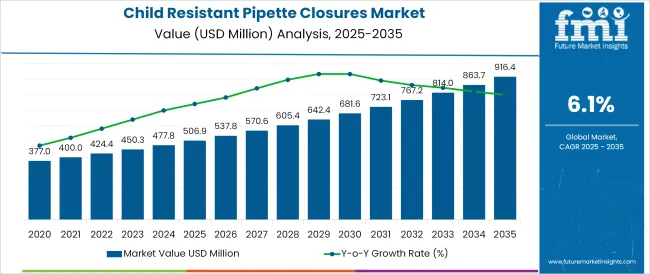
The child resistant pipette closures market is witnessing notable growth as regulatory compliance, consumer safety awareness, and demand for premium, tamper proof packaging converge. Stricter guidelines on child safety packaging for pharmaceuticals, nutraceuticals, and certain chemicals have strengthened the adoption of these closures.
Increasing consumer preference for secure yet convenient dispensing solutions, coupled with the growth of regulated categories such as CBD oils, liquid medicines, and essential oils, is driving market penetration. Advancements in material engineering and design have made closures both user friendly for adults and robust enough to prevent child access, aligning with evolving safety standards.
Looking ahead, the market is expected to benefit from rising demand for compliant, branded packaging in emerging regions, alongside innovations in recyclable and aesthetically pleasing closure designs, paving the way for sustained adoption across healthcare and personal care industries.
The market is segmented by Product Type, Type, Neck Diameter, Material, and Sales Channel and region. By Product Type, the market is divided into Push & Turn, Squeeze & Turn, and Others.
In terms of Type, the market is classified into Tamper Evident and Non-Tamper Evident. Based on Neck Diameter, the market is segmented into 20-40 mm, Below 20 mm, 40-60 mm, and Above 60 mm. By Material, the market is divided into PP (Polypropylene), LDPE (Low-density polyethylene), PE (polyethylene), and Others.
By Sales Channel, the market is segmented into Pharmaceuticals Stores, Retail Channels, Online Channel, Third Party Website, Direct to Customer, and Others. Regionally, the market is classified into North America, Latin America, Western Europe, Eastern Europe, Balkan & Baltic Countries, Russia & Belarus, Central Asia, East Asia, South Asia & Pacific, and the Middle East & Africa.
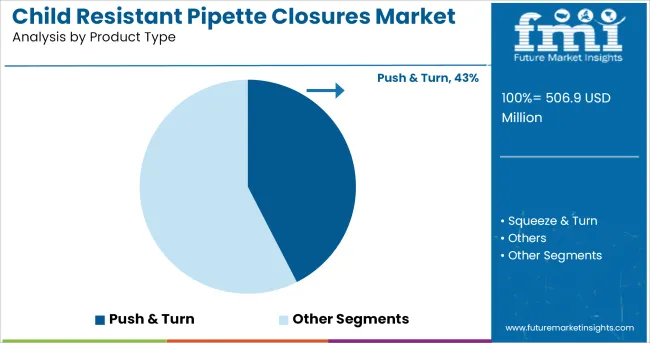
When segmented by product type, push & turn closures are anticipated to account for 42.5% of the market revenue in 2025, establishing themselves as the leading product category. This dominance is attributed to their intuitive, widely recognized mechanism that balances safety with ease of use for adults.
The design ensures compliance with child resistance regulations while offering reliable functionality across diverse liquid products. The ability to integrate seamlessly with existing pipette systems and maintain consistent performance over repeated use has further supported their preference among manufacturers.
Additionally, the cost-effectiveness of producing standardized push & turn mechanisms at scale, combined with consumer familiarity and trust in this closure type, has reinforced its market leadership.
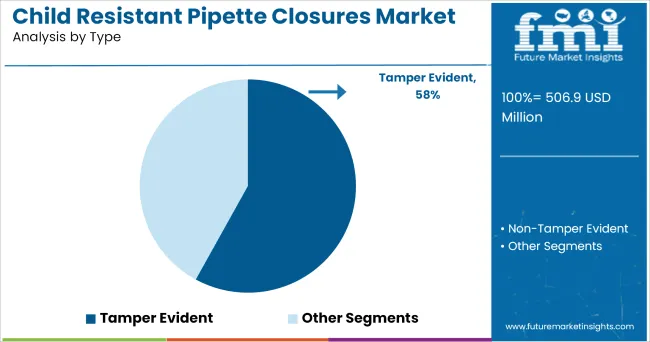
By type, tamper evident closures are expected to capture 58.0% of the market revenue in 2025, ranking as the most prominent segment. This position has been bolstered by increasing regulatory and consumer demand for packaging that clearly indicates first-time opening.
The integration of tamper evident features into child resistant designs has allowed manufacturers to meet dual objectives of safety and authenticity assurance. End users have increasingly preferred these closures as they convey product integrity and enhance consumer confidence in sensitive applications such as pharmaceuticals and nutraceuticals.
The ability to deter counterfeiting and reassure users of product safety has further strengthened the adoption of tamper evident closures, solidifying their leading share.
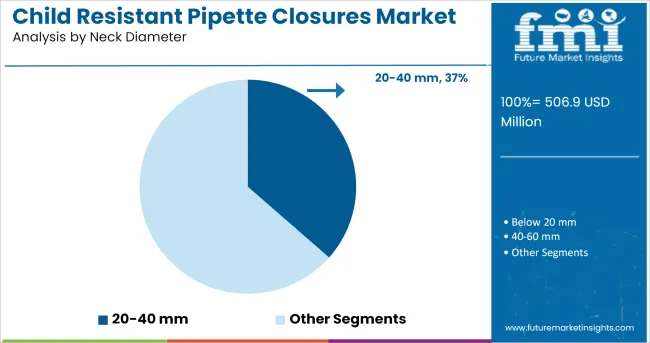
Segmenting by neck diameter reveals that the 20-40 mm range is projected to hold 36.5% of the market revenue in 2025, positioning it as the dominant segment. This leadership arises from its versatility and compatibility with a wide array of bottles commonly used in the healthcare, personal care, and specialty chemical industries.
Manufacturers have favored this diameter range due to its balance of ergonomic usability, adequate dispensing control, and regulatory compliance. Its ability to accommodate standard pipette sizes while ensuring secure closure has supported its widespread adoption.
Furthermore, the prevalence of bottle designs within this neck size in regulated markets has reinforced its dominance, as it enables consistent application of child resistant and tamper evident features without compromising product aesthetics or functionality.
Government agencies have imposed strict restrictions requiring the use of child-resistant pipette closures on products that could endanger the health of children around the world. In the United States, the Poison Prevention Packaging Act (PPPA) specifies which items must be packed with child-resistant pipette closures.
Drugs and dietary supplements, chemical goods, and mouthwash prods and cosmetic products are few of the items on the list. The market is expected to increase at a significant rate as a result of the implementation of severe laws regarding the use of Child resistant pipette closures.
Child resistant packaging products, such as pipette closures, are receiving more attention. Pharmaceutical packaging producers are focusing on child-resistant container types like droppers, caps and closures. According to the European Child Safety Alliance, every year in Europe, 3,000 children under the age of 14 die from acute poisoning after acquiring access to pharmaceutical items.
Furthermore, according to the WHO, poisoning was responsible for 4% of global child injury deaths (0-17 years of age) in 2020. As a result, manufacturers are concentrating on the development of child-resistant packaging, such as pipette closures. More advancements are projected to open up new growth potential for the global pipette closures market.
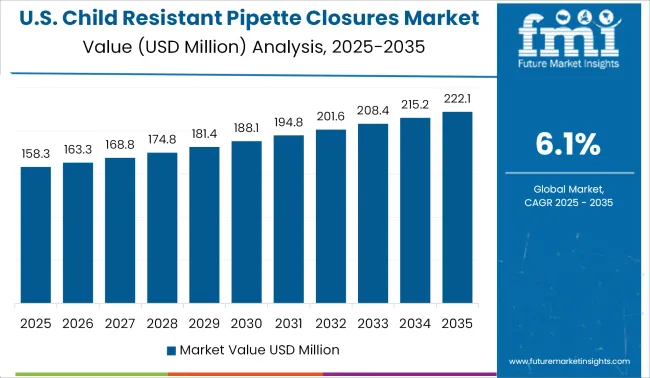
In terms of revenue, North America had the largest market share of the child resistant pipette closures market in 2024. Over the projected period of the research, the regional market is expected to remain the most attractive and promising market with US holding around 80% of the North America’s market share by value.
Well-established pharmaceutical packaging business, as well as a strong predilection for bottles as a product type, can be credited with the growth of region. Over the forecast period, the North American market for child resistant pipette closures is predicted to grow at a CAGR of more than 7 percent, with sales concentrated in the United States.
Because of the constantly developing pharmaceutical and pharmaceutical packaging sectors, the markets in Europe and Asia Pacific are projected to stay competitive and present attractive growth possibilities. Over the forecast period, the Europe market is expected to grow at a CAGR of more than 4.5 percent.
By the end of 2025, the APAC market is estimated to increase at a CAGR of over little 6 percent, accounting for one third of total market volume.
The Latin American market for child-resistant pipette closures is predicted to account for less than 10 percent of the global market revenue share and increase at a CAGR of 4.5%. Overviewing the market scenario for different regions, the market for child resistant pipette closure stands lucrative over the forecast period.
The global child resistant pipette closures market is classified into three types of closures that is push & turn, squeeze & turn, and others. By the end of 2025, push and turn closure is predicted to command a global revenue share of more than half the total market. While others segment are set to witness substantial growth during the assessment period.
Secondly, pharmaceuticals, household and personal care, chemicals and food and beverage, are the end-use segments of the global market. By the end of 2025, the Pharmaceuticals category is estimated to account for more than two third of total market revenue. As the product finds it extensive use case in the pharmaceutical industry.
Adding to that, the global market is divided into four categories according on material type: PP, LDPE, PE, and Others. Because of its chemical inert qualities and lack of reactivity with the packaged product, PP is projected to dominate among the various material type during the upcoming period.
Moreover, the global market is divided into tamper evident and non-tamper evident segments based on tamper evidence. Throughout the forecast period, the tamper evident category is expected to maintain its dominance. Tamper-evident closures, as well as a child-resistant feature, ensuring that the product is carried in its original condition.
The aforementioned factors showcase the segment wise scenario for the child resistant pipette closure market enabling higher growth prospective for new investors looking for revenue generation.
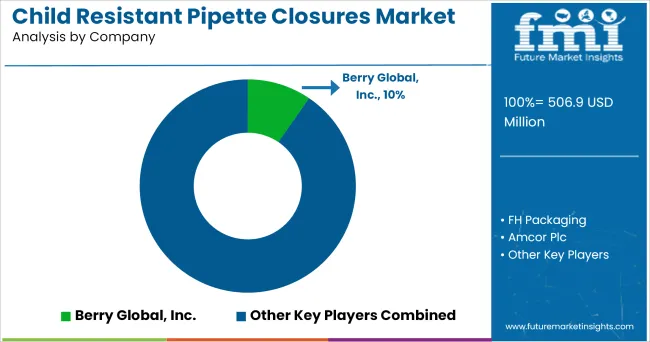
are the prominent players listed across the value chain of the child resistant Pipette closures market.
Virospack's CRC and tamper-resistant solutions have taken the packaging market to next level. In June 2020, their safe droppers have received child-resistant certification from the Code of Federal Regulations. The development of the magnetic dropper with a magnetic seal is another notable progression in their unique techniques that has propelled them to the pinnacles of success.
Product diversification techniques, numerous sales channels, and product warehousing are being used by newer entrants to try to acquire a portion of the global market. Front runners has also created a number of pipette closure inserts in a variety of sizes and materials, demonstrating their product extension capabilities.
To acquire broader coverage, the producers have streamlined their supply chain network with modern trade channels, pharmaceutical outlets, and an online channel. The market is moderately fragmented, with a large number of regional companies competing on the price of child resistant pipette closures.
The report is a compilation of first-hand information, qualitative and quantitative assessment by industry analysts, inputs from industry experts and industry participants across the value chain. The report provides in-depth analysis of parent market trends, macro-economic indicators and governing factors along with market attractiveness as per segments. The report also maps the qualitative impact of various market factors on market segments and geographies.
The global child resistant pipette closures market is estimated to be valued at USD 506.9 million in 2025.
The market size for the child resistant pipette closures market is projected to reach USD 916.4 million by 2035.
The child resistant pipette closures market is expected to grow at a 6.1% CAGR between 2025 and 2035.
The key product types in child resistant pipette closures market are push & turn, squeeze & turn and others.
In terms of type, tamper evident segment to command 58.0% share in the child resistant pipette closures market in 2025.






Our Research Products

The "Full Research Suite" delivers actionable market intel, deep dives on markets or technologies, so clients act faster, cut risk, and unlock growth.

The Leaderboard benchmarks and ranks top vendors, classifying them as Established Leaders, Leading Challengers, or Disruptors & Challengers.

Locates where complements amplify value and substitutes erode it, forecasting net impact by horizon

We deliver granular, decision-grade intel: market sizing, 5-year forecasts, pricing, adoption, usage, revenue, and operational KPIs—plus competitor tracking, regulation, and value chains—across 60 countries broadly.

Spot the shifts before they hit your P&L. We track inflection points, adoption curves, pricing moves, and ecosystem plays to show where demand is heading, why it is changing, and what to do next across high-growth markets and disruptive tech

Real-time reads of user behavior. We track shifting priorities, perceptions of today’s and next-gen services, and provider experience, then pace how fast tech moves from trial to adoption, blending buyer, consumer, and channel inputs with social signals (#WhySwitch, #UX).

Partner with our analyst team to build a custom report designed around your business priorities. From analysing market trends to assessing competitors or crafting bespoke datasets, we tailor insights to your needs.
Supplier Intelligence
Discovery & Profiling
Capacity & Footprint
Performance & Risk
Compliance & Governance
Commercial Readiness
Who Supplies Whom
Scorecards & Shortlists
Playbooks & Docs
Category Intelligence
Definition & Scope
Demand & Use Cases
Cost Drivers
Market Structure
Supply Chain Map
Trade & Policy
Operating Norms
Deliverables
Buyer Intelligence
Account Basics
Spend & Scope
Procurement Model
Vendor Requirements
Terms & Policies
Entry Strategy
Pain Points & Triggers
Outputs
Pricing Analysis
Benchmarks
Trends
Should-Cost
Indexation
Landed Cost
Commercial Terms
Deliverables
Brand Analysis
Positioning & Value Prop
Share & Presence
Customer Evidence
Go-to-Market
Digital & Reputation
Compliance & Trust
KPIs & Gaps
Outputs
Full Research Suite comprises of:
Market outlook & trends analysis
Interviews & case studies
Strategic recommendations
Vendor profiles & capabilities analysis
5-year forecasts
8 regions and 60+ country-level data splits
Market segment data splits
12 months of continuous data updates
DELIVERED AS:
PDF EXCEL ONLINE
Market Share Distribution Among Child Resistant Pipette Closures Manufacturers
Children Enteral Nutrition Market Size and Share Forecast Outlook 2025 to 2035
Child Safety Seats Market Growth - Trends & Forecast 2025 to 2035
Children’s Health Supplement Market Analysis by Product Type, Application and Age Group Through 2025 to 2035.
Children Mattress Market Product Type, Ingredient Type, Sales Channel, and Region - Trends, Growth & Forecast 2025 to 2035
Child resistant Zipper Market Size and Share Forecast Outlook 2025 to 2035
Child-Resistant Pumps Market Size and Share Forecast Outlook 2025 to 2035
Child Resistant Re-Closable Edible Bags Market Size and Share Forecast Outlook 2025 to 2035
Child-Resistant Foil Packaging Market Size and Share Forecast Outlook 2025 to 2035
Child Resistant Pouches Market Size and Share Forecast Outlook 2025 to 2035
Child Resistant Single Dose Pouches Market Size and Share Forecast Outlook 2025 to 2035
Child Resistant Dropper Caps Market Size and Share Forecast Outlook 2025 to 2035
Child Resistant Bottles Market Size and Forecast
Child Resistant Locking Pouches Market from 2025 to 2035
Child-Resistant Containers Market Trends & Demand 2025 to 2035
Competitive Landscape of Child Resistant Re-Closable Edible Bags Providers
Market Share Distribution Among Child-Resistant Pouches Manufacturers
Leading Providers & Market Share in Child-Resistant Foil Packaging
Market Share Insights for Child Resistant Dropper Caps Manufacturers
Child Resistant Bags Market

Thank you!
You will receive an email from our Business Development Manager. Please be sure to check your SPAM/JUNK folder too.
Chat With
MaRIA